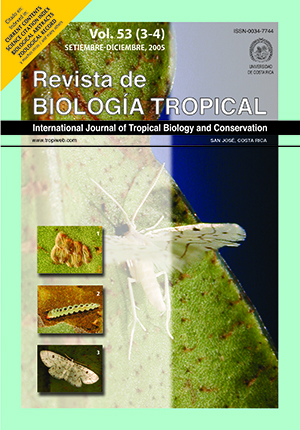Abstract
We evaluated discontinuous cultures (Algal medium at 0.5 mM of NaNO3, and 27% NaCl) of five strains of Dunaliella sp. isolated from Venezuelan hypersaline lagoons (Araya, Coche, Peonía, Cumaraguas, and Boca Chica) and one strain from a reference collection (Dunaliella salina, LB1644). Cultures were maintained to 25±1 °C, with constant aeration, photoperiod 12:12, and two light intensities (195 and 390 μE.m-2.s-1) during 30 days. Cell count was recorded on a daily basis using a Neubaüer camera. Totals of chlorophyll a and carotenoids were measured at the end of the experiment. The largest cellular densities were measured during the smallest light intensities. The strain with the largest cellular density was isolated from Boca Chica (8 x106 and 2.5 x106 cel.ml-1 a 390 and 195μE.m-2.s-1, respectively). The increment of light intensity produced a significant reduction of growth rates in all strains. Totals of carotenoids by volume were as large as 390 μE.m-2.s-1. Strains LB1644, from Coche and Araya were those that produced the largest amount of carotenoids (38.4; 32.8 and 21.0 μg.ml-1, respectively). Differences total carotenoids by cell between treatments were significant. The largest concentration was 390 μE.m-2.s-1. The strains LB1644 and Coche produced the highest values of carotenes (137.14 and 106.06 pg.cel-1, respectively). Differences in the relation carotenoid:chlorophyll a between the strains at various light intensities was significant. Strains LB1644 presented the largest value of the relation carotenoids:chlorophyll a (20:1) at 195 μE.m-2.s-1. No significant differences were detected in the strain Coche (15:1). All the other strains showed relations lower than one. Our results suggest that the strains of Coche and Araya show potential to be used in the biotechnology of carotenoids production.References
Ben-Amotz, A. 1980. Glycerol production in the alga Dunaliella, p. 191-208. In A. San Pietro (ed.). Biochemical and photosynthetic aspects of energy production. Academic, Nueva York, Nueva York.
Ben-Amotz, A. 1987. Effect of irradiance and nutrient defienciency on the chemical composition of Dunaliella bardawil Ben-Amotz and Avron (Volvocales, Chlorophyta). J. Plant Physiol. 131: 479-487.
Ben-Amotz, A. & M. Avron.1983. On the factors which determine massive β-carotene accumulation in the halotolerant alga Dunaliella bardawil. Plant Physiol. 72: 593-597.
Borowitzka, M. & L. Borowitzka. 1988. Dunaliella, p. 27-58. In M. Borowitzka & L. Borowitzka (eds.). Microalgal Biotechnology. Cambridge University, Cambridge, Inglaterra.
Borowitzka, M., L. Borowitzka & D. Kessly. 1990. Effects of salinity increase on carotenoid accumulation in the green alga Dunaliella salina. J. Appl. Phycol. 2: 111-119.
Cifuentes, A., M. González, M. Conejeros, V. Dellarossa & O. Parra. 1992. Growth and carotenogenesis in eight
strains of Dunaliella salina Teodoresco from Chile. J. Appl. Phycol. 4: 111-118.
Cifuentes, A., M. González, O. Parra & M. Zúñiga. 1996. Cultivo de cepas de Dunaliella salina (Teodoresco
en diferentes medios bajo condiciones de laboratorio. Rev. Chil. Hist. Nat. 69: 105-112.
Fábregas, J., C. Herrero, B. Cabezas, R. Liaño & J. Abalde. 1986. Response of the marine microalga
Dunaliella tertiolecta to nutrient concentration and salinity variations in batch cultures. J. Plant Physiol. 125: 475-484.
Gómez, J., Z. Ramazanov, A. Fontes & G. García. 1992. Photosynthetic characteristics of Dunaliella salina
(Chlorophyceae, Dunaliellales ) in relation to β-carotene content. J. Appl. Phycol. 4: 11-15.
Gómez, P., A. Barriga, A. Cifuentes & M. González. 2003. Effect of salinity on the quantity and quality of
carotenoids accumulated by Dunaliella salina (strain CONC-007) and Dunaliella bardawil (strain ATCC 30861). Biol. Res. 36: 185-192.
Loeblich, L.1982. Photosynthesis and pigments influenced by light intensity and salinity in the halophile Dunaliella salina (Chlorophyta). J. Mar. Biol. Ass. UK. 62: 493-508.
Madigan, M., J. Martinko & J. Parker. 1999. Brock Biología de los microorganismos.. Prentice Hall Iberia, Madrid, España.1064 p.
Marín, N., F. Morales, C. Lodeiros & E. Tamigneaux. 1998. Effect of nitrate concentration on growth and pigments synthesis of Dunaliella salina cultivated under low illumination and preadapted to different salinities. J. Appl. Phycol. 10: 405-411.
Masuda, T., J. Polle & A. Mellis. 2002. Biosynthesis and distribution of chlorophyll among the photosystems during recovery of the green alga Dunaliella salina from irradiance stress. Plant Physiol. 128: 603-614. Mc Lachlan, J. 1973. Growth media-marine, p. 25-51. In J. Stein (ed.). Handbook of phycological methods. Culture methods and growth measurements. Cambridge University, Cambridge, Inglaterra.
Mendoza, H., A. Martel, M. Jiménez & M. García. 1999. Oleic acid is the main fatty acid related with carotenogenesis in Dunaliella salina. J. Appl. Phycol. 11: 15-19.
Sokal, R. & F. Rohlf. 1995. The principles and practice of statistics in biological research. Third edition. W. H. Freeman, Nueva York. 887 p.
Wegmann, K. & H. Metzner. 1971. Synchronization of Dunaliella salina cultures. Arch. Mikrobiol. 78: 360-367.
##plugins.facebook.comentarios##

This work is licensed under a Creative Commons Attribution 4.0 International License.
Copyright (c) 2005 Revista de Biología Tropical






